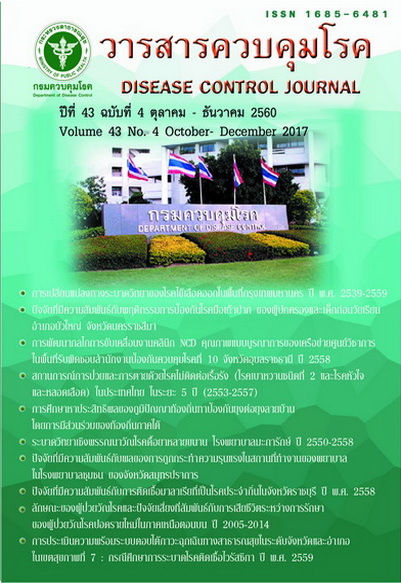Evaluation of preparedness for public health emergency response at provincial and district level of Health Inspection Region 7: case study of Zika virus epidemic, 2016
DOI:
https://doi.org/10.14456/dcj.2017.10Keywords:
public health emergency response, Zika virus disease, preparednessAbstract
This evaluation study aimed to evaluate preparedness of public health emergency response related to input, process, output, and reflect on components of successful and obstacles at provincial and district level, from a case study of Zika virus epidemic in 2016. The study was conducted in 4 provinces, and 6 districts in 7 health areas which reported Zika cases. Purposive sampling was used to recruit (1) 20 administrators (2) Officers who were responsible for emergency response of emergency response centers at provincial level (4 provinces with 5 persons each). The total number of officers at provincial level was 20 persons, and the total number of officers at district level was 51 persons. Thus, the total number of officers was 71 persons, and (3) 400 people. Data were collected using questionnaires, interviews, focus group and related documents. Quantitative data were analyzed using number and percentage and quality data were analyzed by content analysis. Results of the study found that at provincial level had a clear policy and had emergency response centers every areas. Fifty percent of officers were trained for public health emergency management and every provinces had planned for readiness emergency response and risk surveillance of Zika. At district level found that 4 out of 6 districts had notification of appointment health emergency incidence committees system and had clear responsibility. Every district were able to operate emergency operation centers. Only 5.9% of officers were trained and 50.0% had preparedness plans of emergency response. One hundred percent had sparring practice and 80.4% had Zika risk surveillance. Regarding process evaluation, at provincial level found that they had information systems and 85.0% were able to use for emergency response. Supportive resources for emergency response (budget, material and equipment) were sufficient, and 90.0% had sufficient communication about risk to target population. Moreover, 85.0% officers monitored working practice in the area and 60.0% were able to practice emergency response. At district level, it found that 80.4% had information system and were able to use for emergency response. Supportive resources for emergency response (equipment) had sufficient and 86.3% could communicate about risk to target population Moreover, 80.4% officials monitored practice in the areas. However, only 58.8% of officers could respond to emergency situations. When considering outputs, it found that the 75.0% of provinces and 83.3% of district were able to control the Zika virus infection. At district level, after 28 days of having first Zika case reported, 66.7% of districts were able to control aquatic index and container index at 0. Eighty five point five percent of people had knowledge about Zika disease, and 78.6% were also able to prevent the disease. They also could feedback helpful data to officers who were responsible to control Zika virus for improving work. Successful component was leadership of incidence command, data for early warning coordination and corporation with related networks. Obstacle dimension was local officers lacking of knowledge related to concept of emergency response management, emergency operation center and incidence command system. Additionally, there was, high turnover rate of officers, strategy change frequently, and lack of community participation for prevention and control the disease. The results of this study inform that related officers need to develop more knowledge related to public health emergency management, Emergency Operations Center and Incident Command System. For all hazard, it has to register in provincial and district levels and work collaboratively. Command structure has to have an officer for practicing expected role.
Downloads
References
2. World Health Organization. WHO checklist for influenza pandemic preparedness planning World Health Organization [Internet]. 2005 [cited 2017 Jan 6]. Available from: http://www.who.int/ csr/resources/publications/influenza/WHO_ CDS_CSR_GIP_2005_4/en
3. สำนักระบาดวิทยา กรมควบคุมโรค กระทรวง สาธารณสุข. กรอบแนวทางการพัฒนาศูนย์ปฏิบัติ การภาวะฉุกเฉิน และระบบบัญชาการเหตุการณ์ใน ภาวะทางสาธารณสุข กรมควบคุมโรค พ.ศ. 2559- 2564. กรุงเทพมหานคร: ชุมนุมสหกรณ์การเกษตร แห่งประเทศไทย; 2559.
4. World Health Organization. Zika virus outbreak global response: interim report May 2016. World Health Organization [Internet]. 2017 [cited 2017 May 6]. Available from: http://www.who.int/ iris/handle/10665/207474
5. World Health Organization. Zika situation report [Internet]. 2017 [cited 2017 Jan 6]. Available from: http://www.who.int/emergencies/zika -virus/situation-report/Zika-timeline-2017. png?ua=1
6. สำนักระบาดวิทยา กรมควบคุมโรค กระทรวง สาธารณสุข. DDC WATCH จับตาโรคและภัยสุขภาพ ปีที่ 3 ฉบับพิเศษ ก.พ. 2559 [อินเทอร์เน็ต]. 2559 [สืบค้นเมื่อ 6 ม.ค. 2560]. แหล่งข้อมูล: http:// www.boe.moph.go.th
7. สำนักงานป้องกันควบคุมโรคที่ 7 จังหวัดขอนแก่น. สถานการณ์ผู้ติดเชื้อไวรัสซิกาและการดำเนินงาน ป้องกันควบคุมโรค เขตสุขภาพที่ 7. ขอนแก่น: สำนักงานป้องกันควบคุมโรคที่ 7 จังหวัดขอนแก่น; 2559.
8. Kate KE, Nikkita G, Marc A, Adam S, Deborah B, John L, et al. Global trends in emerging infectious disease. Nature 2008;451:990-3.
9. สมัชชาสุขภาพแห่งชาติ. โรคติดต่ออุบัติใหม่ 2552 [อินเทอร์เน็ต]. 2559 [สืบค้นเมื่อ 6 ม.ค. 2560]. แหล่งข้อมูล: https://www.samatcha.org/node/92
10. ขนิษฐา พุกกะณานนท์. การศึกษาแนวทางการ บริหารจัดการการป้องกันและบรรเทาสาธารณภัย ขององค์การบริหารส่วนตำบลบางปลา อ.บางพลี จ.สมุทรปราการ [รายงานการศึกษาอิสระปริญญารัฐประศาสนศาสตรมหาบัณฑิ ต]. ขอนแก่น:วิทยาลัยการปกครองท้องถิ่น มหาวิทยาลัยขอนแก่น; 2551. 150 หน้า.
11. พันธุ์ทิพย์ รามสูตร, สมใจ ประมาณผล, บังอร เทพ เพียร. ความต้องการและความพร้อมขององค์กรใน การสร้างเสริมสมรรถนะด้านการเฝ้าระวัง ป้องกัน และควบคุมโรค. วารสารสาธารณสุขและการพัฒนา 2551;6:1-10.
12. วิไลวรรณ นาเงิน, สุทัศน์ กองขุนทด. รูปแบบการ บริหารจัดการสาธารณภัยของหน่วยงานสังกัด กระทรวงสาธารณสุข ตามแผนป้องกันและบรรเทา สาธารณภัย ด้านการแพทย์
และสาธารณสุข. วารสาร แพทย์เขต 4-5 2559;35:188-97.
13. Anbari F. T. A systems approach to project evaluation. Project Management Journal 1985;16:21-6.
14. วรยา เหลืองอ่อน, กิตติ์พงษ์ สัญชาตวิรุฬ, ยงเจือ เหล่าศิริถาวร, โสภณ เอี่ยมศิริถาวร, ธีรวัฒน์ วลัยเสถียร, ศศิธร ตั้งสวัสดิ์, และคณะ. การจัดการ ภาวะฉุกเฉินทางด้านสาธารณสุข; วันที่ 6-19 กันยายน 2558; ศูนย์ควบคุมและป้องกันโรคแห่งชาติสหรัฐ อเมริกา ประเทศสหรัฐอเมริกา, แอตแลนต้า. นนทบุรี: 2558. หน้า 1-14.
15. รพีพรรณ เดชพิชัย. การประสานข้อสั่งการและการ บริหารจัดการตอบโต้ภาวะฉุกเฉินด้านการควบคุม โรคและภัยสุขภาพ กรณีศึกษา : การระบาดของโรคติดเชื้อไวรัสอีโบลาในแอฟริกาตะวันตก สำนักโรค ติดต่อทั่วไป กรมควบคุมโรค สิงหาคม 2557 - กุมภาพันธ์ 2558. วารสารควบคุมโรค 2559;42: 371-85.
16. อรนุช พิศาลสุทธิกุล, สุเมธ พรหมอินทร์, วันชัย ธรรมสัจการ. พฤติกรรมการป้องกันโรคไข้เลือดออก ของประชาชน กรณีศึกษา: หมู่บ้านในเขตตำบล ควนโพธิ์ อำเภอเมือง จังหวัดสตูล. สงขลานครินทร์ เวชสาร 2552;27:81-9.
17. สำนักโรคติดต่อนำโดยแมลง กรมควบคุมโรค กระทรวงสาธารณสุข. การประเมินผลการเฝ้าระวัง ป้องกันควบคุมโรคไข้เลือดออกภาพรวมระดับ ประเทศ ปี 2554. กรุงเทพมหานคร: ชุมนุมสหกรณ์ การเกษตรแห่งประเทศไทย; 2554.
Downloads
Published
How to Cite
Issue
Section
License
Articles published in the Disease Control Journal are considered as academic work, research or analysis of the personal opinion of the authors, not the opinion of the Thailand Department of Disease Control or editorial team. The authors must be responsible for their articles.






